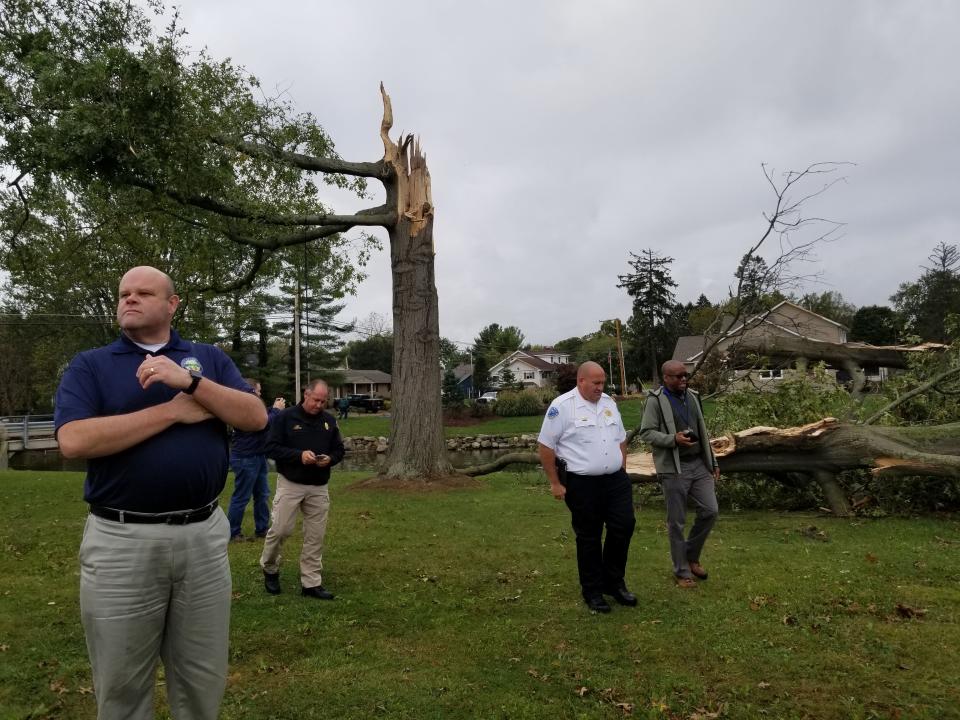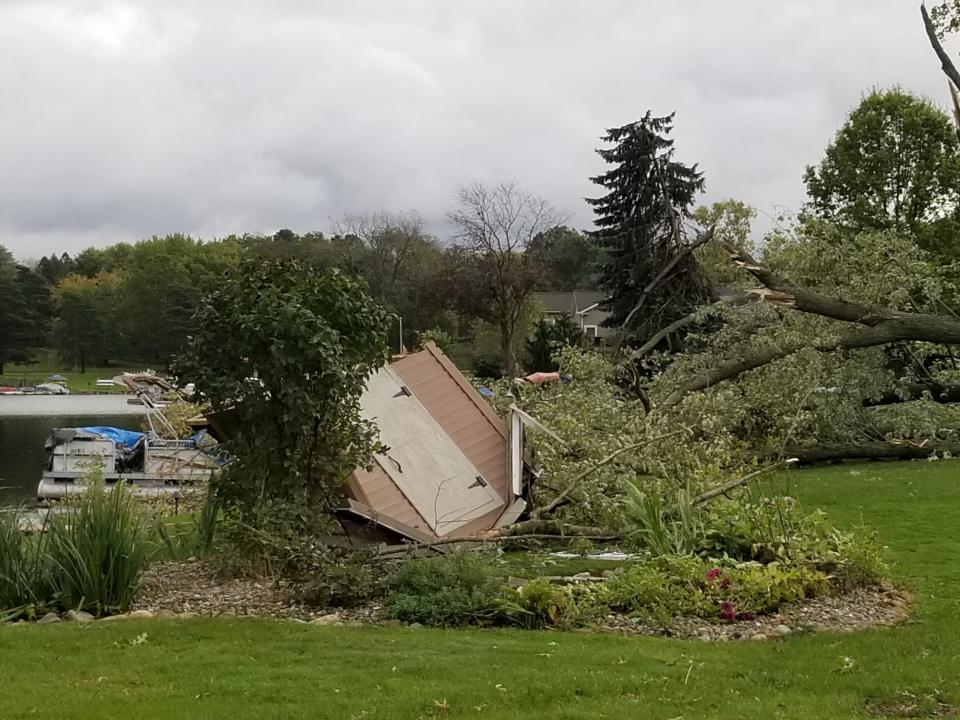Wild weather: Northeast Ohio is ripe for 'average to above-average' tornado season
Whether March will go out like a lion or a lamb remains to be seen.
But weather officials are already expecting an "average to above-average" season when it comes to tornadoes dropping in on this part of the state.
"Looking at the long-range forecast, there's at least a potential for an average to slightly more-active-than-normal chance for tornadoes in this state," said Jim Sullivan, meteorologist for the National Weather Service. "It's impossible to predict months ahead of time, but it might be an active late-spring and early-summer season."
So why are forecasters predicting possibly more tornadoes this year?
"At the National Climate Center for the May-June-July period, they're leaning toward warmer than average temperatures and above-average precipitation," Sullivan said. "That may point to increased severe weather potential, if it's kind of warm, humid and rainy in the late spring and early summer."
Ohio averages about 19 twisters every year, he said, noting that the peak tornado season in Northeast Ohio runs May, June and July.
"This is where we get the bulk of our severe weather," he said. "We get a second, smaller peak in October and November, but it's not as common to get big tornado events in those months."
October storm: Tornado damages homes, topples trees, tosses boat in Jackson Township

How common are tornadoes in Ohio?
The Ohio Committee for Severe Weather Awareness website contains statistics showing that between 1940 and 2020, 1,203 tornadoes have been recorded in Ohio.
While tornadoes have touched down in every month of the year, the highest number of tornadoes have hit each month from April through August. The only difference happened in 2017 when the majority of tornadoes struck in November.
"That was a pretty big tornado outbreak," Sullivan said.
Several tornadoes broke out in Ohio in October, although they were "weak and short-lived," he said. "Every now and then, we do get a bigger event in the fall."
Tornadoes are "slightly more common for western Ohio, a little less common in southeast Ohio and northeastern Ohio is somewhere in the middle," he said.

What's the difference between a tornado watch and a warning?
The National Weather Service provides two types of warnings when it comes to tornadoes. There's a "watch" and a "warning." What's the difference?
The weather agency issues a warning when a tornado has been spotted on radar or by eyewitnesses. In these cases, people need to seek shelter immediately.
A watch is issued when the conditions are favorable for tornadoes. They are usually issued for a four- to eight-hour period, the National Weather Service says.
What is the Fujita scale?
Sullivan said this region, which includes the area from Wooster east through Stark County, typically sees "a lot of tornadoes that are EF0s and EF1s," which are weaker tornadoes.
While the winds whip pretty wild during those storms, they're on the lower end of the Fujita scale, created by a meteorologist Dr. T. Theodore Fujita to estimate wind speeds based on damage caused by tornadoes. The scale has since been enhanced, hence the "E" in front of the "F," to consider more variables when estimating a tornado's wind speed, according to the National Weather Service.
F0 is considered the weakest and F5 is the strongest. An F0 can have gusts that range between 65 mph and 85 mph while an F5 features gusts of over 200 mph.
Support local journalism. Subscribe to the Canton Repository today to access all of our content online at www.cantonrep.com/subscribenow/.
While homeowner's insurance typically covers damage done by tornadoes, the monetary damage these storms do is high. Tim Warstler, Stark County Emergency Management Agency director, said the tornado that struck Jackson Township on April 28, 2002 resulted in damage that was "easily in the millions of dollars."
In the Canton area, there have been no tornadoes more powerful than an F2 in over 70 years, according to GeoStat.org.
But National Weather Service meteorologist Freddie Zeigler is investigating a report that an F3 struck Stark County just nine years earlier. Zeigler was teaching a Skywarn class recently when the subject came up.
Zeigler said that an independent database called tornadoarchive.com contains an account of an F3 tornado that started in Navarre and moved into southwest Canton on Aug. 14, 1943. That twister left one person dead and 34 people injured, he said. It ran 9.7 miles with a width of about 200 yards.
Zeigler is trying to confirm it because it reportedly happened before the weather service's current database, which starts in 1950,
Where have recent tornadoes hit in Northeast Ohio?
Northeast Ohio has seen its share of damaging tornadoes:
The most recent F2 in the Wooster area happened on Sept. 16, 2010 when 130 mph winds tore through the Ohio Agricultural Research and Development Center. The tops of trees were sheared off and others were uprooted; cars were overturned; windows were blown out of buildings and some homes and barns were destroyed, the Wooster Daily Record reported. Green Thumb Floral was destroyed, as were greenhouses and research at the OARDC.
Summit County saw more than $1 million in damage in Stow and Cuyahoga Falls when an F3 hit July 12, 1992, according to the Ohio History Connection. That tornado was just one of 28 that broke out across the state that day.
In May 31, 1985 in southern Trumbull County, an F5 tornado left eight people dead and 210 people injured, Sullivan said. According to tornadoproject.com, which tracks tornados as far back as 1884, the 1985 tornado was one of only 13 storms in the state to result in five or more deaths. It damaged parts of Newton Falls, Lordstown, Niles, Coalburg and Hubbard.
All but one of those 13 deadliest tornadoes occurred during the months of April, May and June. Ten people were killed in western Ohio on March 28, 1920.
The most destructive date for tornadoes in Ohio was on April 3, 1974, as 16 tornadoes touched down, including F5 strength storms in Green, Clark and Hamilton counties that led to 39 deaths and 1,340 injuries. The storms caused more than $250 million in property damage. Heaviest hit was Xenia, where an F5 tornado with winds between 261 and 318 mph decimated nearly half of the city. There was only one hospital left standing, and it was packed with nearly 2,000 people.
"There haven't really been any tornadoes anywhere near that intense in this region anytime since then," Sullivan said.
But that doesn't mean it can't happen.
It's hard to predict tornadoes
While forecasters say tornadoes are hard to predict, it's not completely impossible.
"Usually if we get a tornado, it's the right combination of warm and humid, and there needs to be a proper amount of wind shear in the atmosphere, which means the wind changes in direction and speed as you go up through the atmosphere," Sullivan said. "If the wind is changing as you go up through the atmosphere, that's were the potential lies for a tornado."
Includes reporting by the Akron Beacon Journal and Wooster Daily Record.
Tornado safety tips
• Go to a safe shelter immediately, such as a safe room, basement, storm cellar or a small interior room on the lowest level of a sturdy building.
• Stay away from windows, doors, and outside walls.
• Do not go under an overpass or bridge. You’re safer in a low, flat location.
• Watch out for flying debris that can cause injury or death.
• Use your arms to protect your head and neck.
• If you can’t stay at home, make plans to go to a public shelter.
Source: The National Weather Service
This article originally appeared on The Repository: Weather: Tornado season expected to be busy in Northeast Ohio

